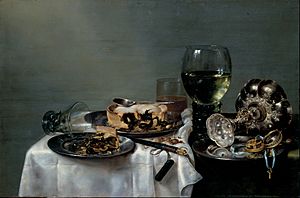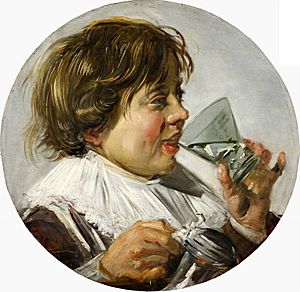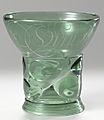Berkemeyer facts for kids

A Berkemeyer is a special type of drinking glass. It has a wide, open top and was first made a long time ago in the 1400s in Germany and the Netherlands. People still make them today! These glasses often have a cool green or yellow color. This color comes from tiny bits of iron in the sand used to make the glass.
Contents
What Makes a Berkemeyer Special?
A Grip That's Easy to Hold
Berkemeyers have a thick, hollow stem. This stem is covered with small bumps called prunts. These prunts were very useful! Imagine eating a big meal with your hands – they might get a bit greasy. The prunts helped people hold onto the glass without it slipping. Another old glass called a römer also had these helpful bumps.
Where Did the Name Come From?
The name Berkemeyer comes from the word berkemei. This word means "birch tree" in an old language. That's because the first Berkemeyers were actually carved from branches of birch trees! These early wooden cups often had lids. The prunts on the glass stems reminded people of the rough bark of those wooden cups. This is how the glass got its name.
Berkemeyers in Art
You can often spot Berkemeyer glasses in old paintings. Many famous artists from the Dutch Golden Age in the 1600s and 1700s loved to paint them. They would show these glasses in beautiful still life paintings. A still life painting shows everyday objects like food, flowers, or dishes arranged on a table. It's like a snapshot of a moment in time. These paintings help us see what life was like long ago and what kinds of things people used.

Images for kids


